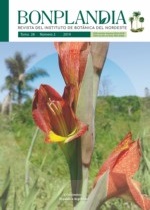Comparative study of medicinal plants related to indigenous and European traditions in Uruguay
DOI:
https://doi.org/10.30972/bon.2823855Keywords:
Ethnobotany, medicinal plants, popular knowledge, UruguayAbstract
This research presents ethnobotanical information on practices related to the medicinal use of plants in urban and rural populations in the departments of Tacuarembó and Canelones, Uruguay. Semi-structured interviews and participant observation were carried out using the ethnographic method. Based on the data provided by the interviewees, the local ethnobotanical knowledge was analyzed and then classified, by comparing the different medicinal uses, the variability of use in relation to the organic system, the forms of consumption, the parts used and the origin of the medicinal plants (MP) in both departments. At the same time, this knowledge was linked to the population origins (indigenous, in Tacuarembó, European, in Canelones). The result was a list of 138 MP. In both departments, plants are used to treat similar health conditions, mainly diseases of the digestive, sensory and respiratory systems. A relationship can be observed between the descent of the interviewees and the forms of use of certain plants, as there is a link between the origin of the plant and its practices with the population contribution in both departments. It is noteworthy that in Tacuarembó, chewing MP is widespread compared to Canelones; it is a habit linked to indigenous traditions.Downloads
Download data is not yet available.
Downloads
Published
2019-07-10
How to Cite
Tabakian, G. (2019). Comparative study of medicinal plants related to indigenous and European traditions in Uruguay. Bonplandia, 28(2), 135–158. https://doi.org/10.30972/bon.2823855
Issue
Section
Original papers
License
Declaration of Adhesion to Open Access
- All contents of Bonplandia journal are available online, open to all and for free, before they are printed.
Copyright Notice
- Bonplandia magazine allows authors to retain their copyright without restrictions.
- The journal is under a Creative Commons Attribution 4.0 International license.















.jpg)


